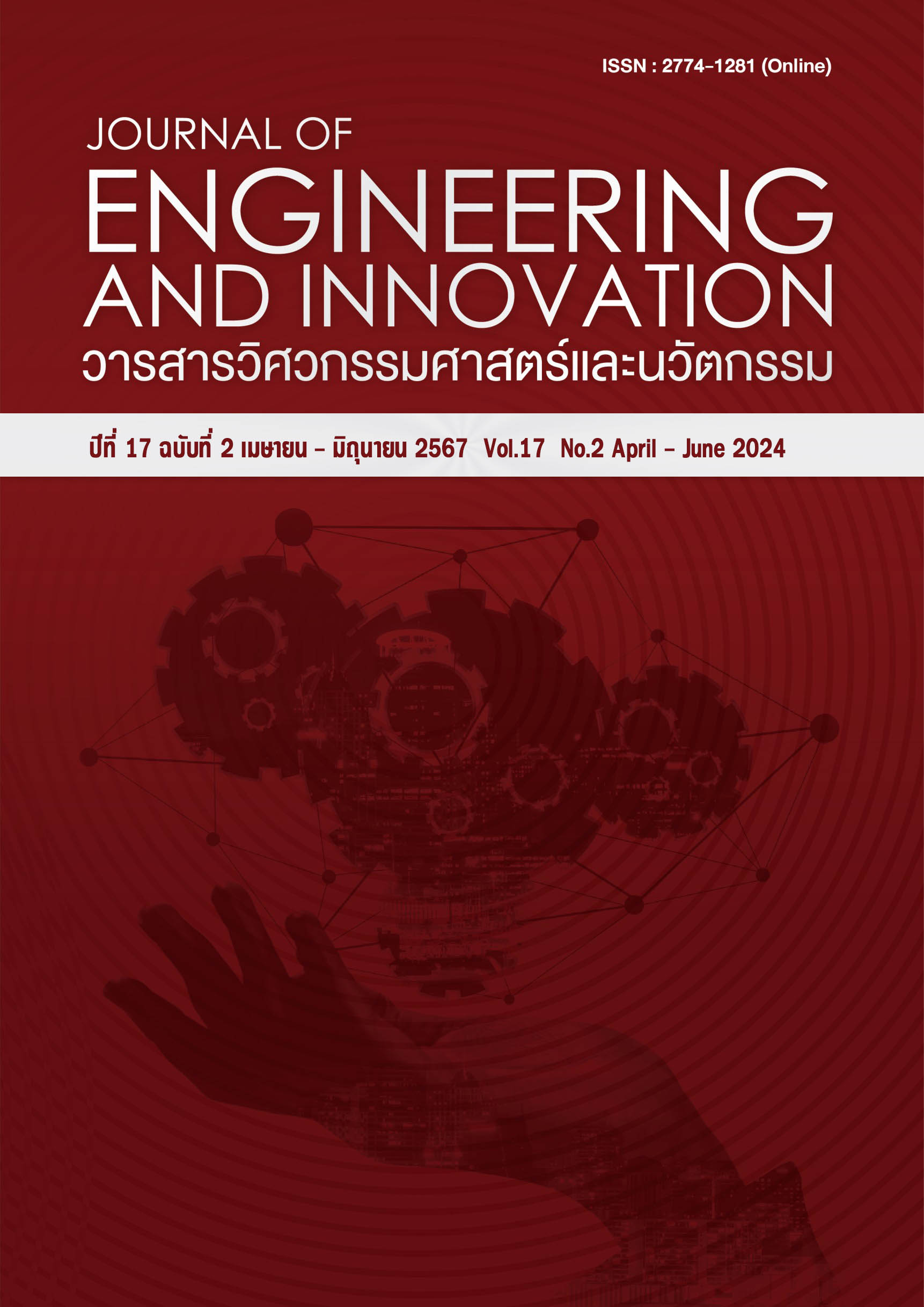การพัฒนากำลังอัดแกนเดียวของวัสดุพื้นทางเดิมปรับปรุงด้วยเถ้าลอย และกากแคลเซียมคาร์ไบด์จีโอโพลิเมอร์
Main Article Content
บทคัดย่อ
งานวิจัยนี้ศึกษาการพัฒนากำลังอัดแกนเดียวของวัสดุพื้นทางเดิมปรับปรุงด้วยเถ้าลอย และกากแคลเซียมคาร์ไบด์ จีโอโพลิเมอร์ ที่อายุบ่ม 7, 14, 28, 60 และ 90 วัน งานวิจัยนี้ศึกษาอิทธิพลของปริมาณสารกระตุ้นซึ่งเป็นส่วนผสมของสารละลายโซเดียมซิลิเกต (NS) และสารละลายโซเดียมไฮดรอกไซด์ (NH) ที่ความเข้มข้น 8 โมลาร์, อัตราส่วนของหินคลุกที่ไม่ผ่านมาตรฐาน:กากแคลเซียมคาร์ไบด์:เถ้าลอย (RCR:CCR:FA) และอัตราส่วน NS:NH พบว่าหน่วยน้ำหนักแห้งสูงสุดของ RCR-CCR-FA จีโอโพลิเมอร์มีค่าลดลงตามปริมาณ FA ที่เพิ่มขึ้นเนื่องจากความถ่วงจำเพาะของ FA ต่ำกว่า กำลังอัดแกนเดียวที่อายุบ่ม 7 วันมีค่าเพิ่มขึ้นตามการเพิ่มของปริมาณ FA เนื่องจากปริมาณซิลิกาและอลูมินาในระบบเพิ่มขึ้น ตัวอย่างที่ปริมาณสารกระตุ้นที่เหมาะสม (Optimum liquid alkaline content, OLC), อัตราส่วน RCR:CCR:FA เท่ากับ 40:10:50 และอัตราส่วน NS:NH เท่ากับ 2 ให้ค่ากำลังอัดแกนเดียวสูงสุดที่อายุบ่ม 7 วัน ซึ่งมีค่าเท่ากับ 9.88 MPa เมื่อเปรียบเทียบค่าเกณฑ์มาตรฐานกำหนดของกรมทางหลวง ทล.-ม.204/2556 มาตรฐานพื้นทางดินซีเมนต์ ซึ่งระบุว่ากำลังอัดต้องไม่น้อยกว่า 1.724 MPa พบว่าทุกอัตราส่วนผสมผ่านเกณฑ์มาตรฐานกำหนดของกรมทางหลวง นอกจากนี้ ได้นำเสนอสมการที่เป็นประโยชน์ในการทำนายกำลังอัดของวัสดุพื้นทางเดิมปรับปรุงด้วยเถ้าลอย และกากแคลเซียมคาร์ไบด์ จีโอโพลิเมอร์ เมื่อทราบกำลังอัดของตัวอย่างที่อายุบ่ม 28 วัน
Article Details
เอกสารอ้างอิง
Suksiripattanapong C, Horpibulsuk S, Boongrasan S, Udomchai A, Chinkulkijniwat A, Arulrajah A. Unit weight, strength and microstructure of a water treatment sludge-fly ash lightweight cellular geopolymer. Construction and Building Materials. 2015;58: 254-257.
Suksiripattanapong C, Horpibulsuk S, Chanprasert P, Sukmak P, Arulrajah A. Compressive strength development in fly ash geopolymer masonsy units manufactured from water treatment sludge. Construction and Building Materials. 2015;82: 20-30.
Makaratat N, Laosamathikul T, Jaturapitakkul C. Utilization of calcium carbide residue –fly ash mixture as a cementing material in concrete. The 33rd Internaltional Association for Bridge and Structural Engineering. 2009;96: 144-149.
Amnadnua K. Tangchirapat W, Jaturapitakkul C. Strength, water permeability, and heat evolution of high strength concrete made from the mixture of calcium carbide residue and fly ash. Materials and Design.2013;51: 894-901.
Phetchuay C, Horpibulsuk S, Arulrajah A, Suksiripattanapong C, Udomchai A. Strength development in soft marine clay stabilized by fly ash and calcium carbide residue based geopolymer. Applied Clay Science. 2016;127-128: 134-142.
Phummiphan I, Horpibulsuk S, Sukmak P, Chinkulkijniwat A, Arulrajah A, Shen SL. Stabilisation of marginal lateritic soil using high calcium fly ash-based geopolymer. Road Materials and Pavement Design. 2016;17(4): 877-891.
Phummiphan I, Horpibulsuk S, Phoo-ngernkham T, Arulrajah A, Shen SL. Marginal Lateritic Soil Stabilized with Calcium Carbride Residue and Fly Ash Geopolymers as a Sustainable Pavement Base Material. Materials in Civil Engineering. 2017;29(2): 1-10.
Rattanasak U, Chindaprasirt P. Influence of NaOH solution on the synthesis of fly ash geopolymer. Minerals Engineering. 2009;22: 1073-1078.
Chindaprasirt P, Chareerat T, Sirivivatnanon V. Workability and strength of coarse high calcium fly ash geopolymer. Cement and Concrete Composites. 2006;29(3): 224-229.

